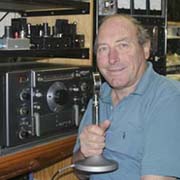
David Macnaughton and his Fascinating World of Amateur Radio
THE HARDINGE BROS. TRANSCEIVER RESTORATION PROJECT
CONTENTS
Please Scroll (16 items)
|
My HARDINGE BROS. 466.12v Click images to view full size A photo of the operating table at VK2BA with the Hardinge Bros. transceiver in operation on 17th May 2007, in contact with VK2BLQ, VK4AXM, VK4ZKT and VK2ATS on 7.125 MHz.
HOW CLOSE TO DISASTER CAN A PIECE OF EQUIPMENT COME ?? This project started when I found an old transceiver on a rubbish dump on a cattle station on the banks of the Darling River in Western NSW. It almost looked too far gone to worry much about, but I asked the station owners about it and they said it had come out of one of the station barns. They couldn't tell me much about the history, but it had to be originally used as a Flying Doctor radio, School of the Air or Rural Fire Service. Actually, it was unlikely to have been used for the latter. It looked as if it had been on the tip for some years and possibly even under water since the Darling River floods at times. The speaker had dissolved but a few dust storms and a heavy shower or two would have had the same result.. It was made in the 1950's by Hardinge Bros. of Melbourne, Australia. I have been told by Reg VK2ATS that he can remember a QSO with VK3TA who is recorded in the 1957 Call Book as B.E. Hardinge, Natimuk Rd, Horsham, Victoria. I would be interested in receiving further information about Hardinge Bros. It has been restored to a working unit, puts out 5 watts of AM and the receiver tunes from 2 to 7.5 MHz, although I must admit that the tracking is poor because I have stretched the high frequency end from the original 6 MHz. It has been back on air making contacts again after all these years. For further information of a very similar unit ( the model 12/54B ) and a circuit diagram, see Silicon Chip magazine for October 2005 FROM THIS:- Shortly I will add the pictures of the final result
|

